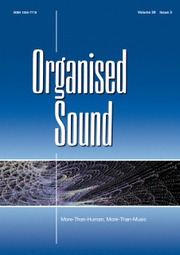Modelling of natural sounds by time–frequency and waveletrepresentations
Published online by Cambridge University Press: 04 April 2001
Abstract
Sound modelling is an important part of the analysis–synthesisprocess since it combines sound processing and algorithmic synthesis within the same formalism. Its aim is to make sound simulators by synthesis methodsbased on signal modelsor physical models, the parameters of which are directly extracted from the analysis of natural sounds. In this article thesuccessive steps for making such systems are described. These are numericalsynthesis and sound generation methods, analysis of natural sounds,particularly time–frequency and time–scale (wavelet) representations, extraction of pertinent parameters, and the determinationof the correspondence between these parameters and those corresponding tothe synthesis models. Additive synthesis, nonlinear synthesis, and waveguide synthesis are discussed.
Information
- Type
- Research Article
- Information
- Copyright
- © 1997 Cambridge University Press
Footnotes
- 8
- Cited by

